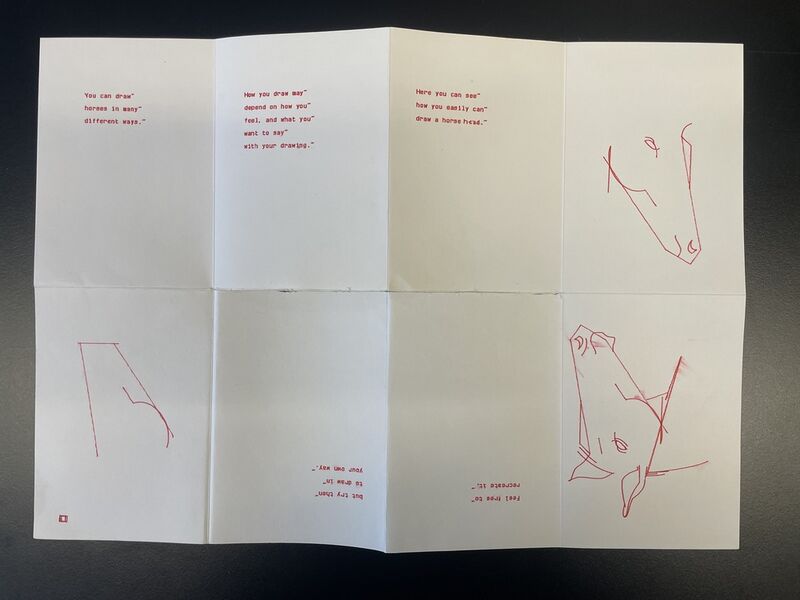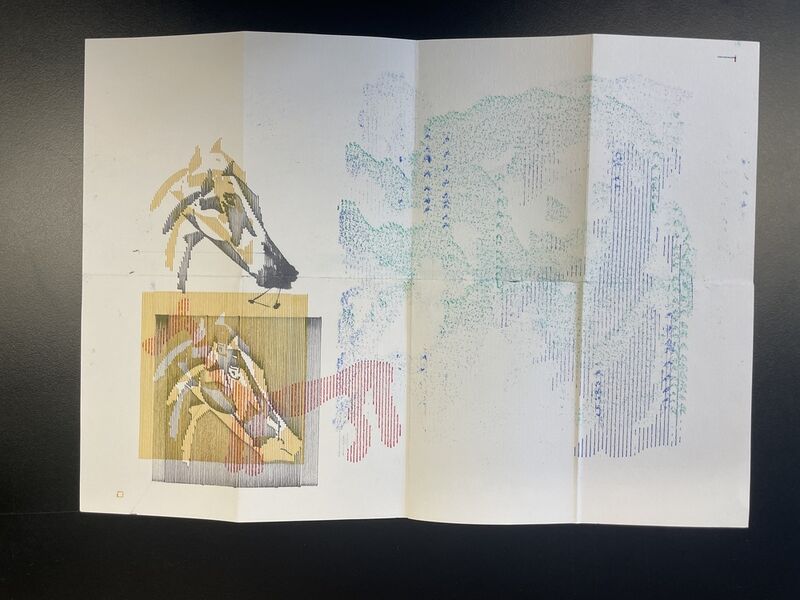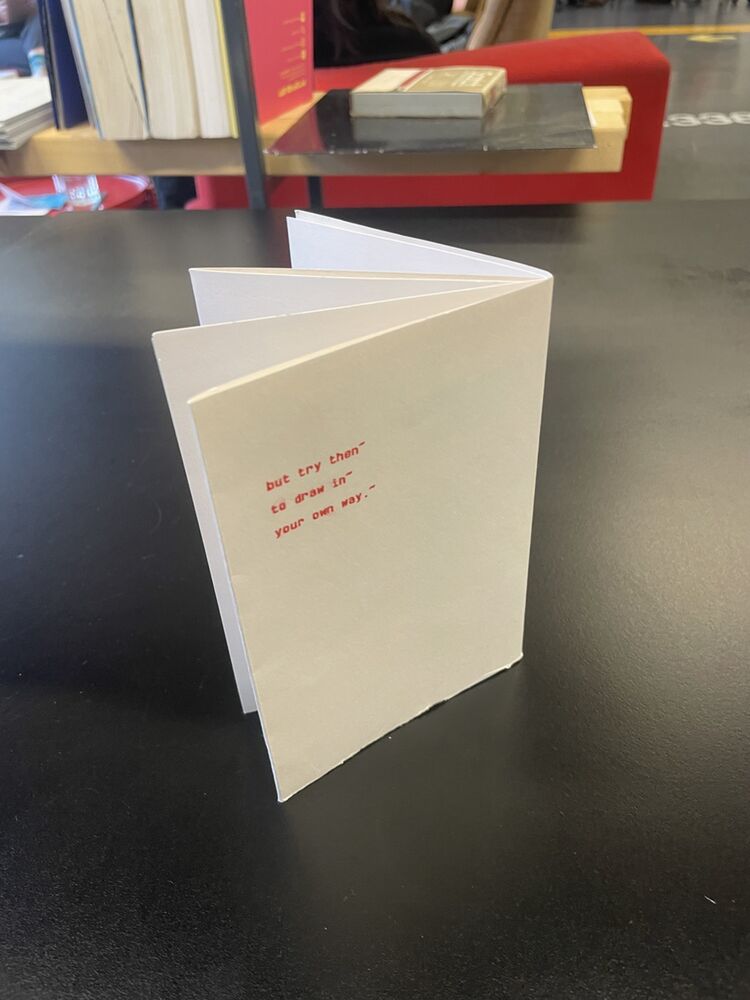User:ØverLørd/Complot
The complot or how I learned to stop worrying and love the machine
The Epic of "Interaction station Alignment Issues", a story of an encounter between the machine and the non-machine
First contact
The plotter labeled "Interaction station Alignment Issues" had been collecting dust in a corner of the XML. Then one day came an eager adventurer who had heard whispers of these ancient machines, that could imitate the human hand and draw with incredible precision without ever getting fatigued. Before even attempting to face these ancient behemoths, the adventurer consulted with one of the High-warlocks of Xpub(Manetta), In order to acquire the spells(Chiplotle) required so that the adventurer could speak the language of the machines.
Drawing Horses In Your Own Way
Through incantations in the forms of ".hpgl"-files and chiplotle3 set up in a virtual environment (don't ask me why, it just happened to work out for all parties involved (why do it easy when you can do it hard?)). bridging the generational gap between my now state-of the art computer with the then state of the art pen plotter a series of adapters are engaged: from the plotter a custom parallel port to serial converter is connected to a USB to RS232 DB9 Serial Adapter Cable, which in turn is connected to a USB to USB-C adapter which plugs into the laptop. Allowing the two machines converse over a plate of chiplotle3. This gave me the opportunity to command the mechanical arm wielding the pen.
After getting to know each other I realized something was not as it should. The pen plotter would stop midway and the yellow(some would even say orange) light, labeled "error" would start blinking. A mangled piece of characters and numbers would then appear in the terminal window, maybe a cry for help, or an apology from the plotter, suggesting we try things differently.
To get back in the plotting saddle chiplotle and the machine must be restarted (in the reverse order). Sometimes the machines also need to be disconnected and reconnected (some personal space is always helpful). Even after all these steps there is a risk of the machine immediately go back in the same catatonic error-state, when asked to plot something new. maybe I should have listened more carefully to the warnings of "alignment issues" and "craps out midway"?
After repeating this choreography for hours I made som observations:
1. The machine seemed to stop randomly every time, even when the same plot was attempted.
- this may suggest that the issue was rather of a mechanical-nature as opposed to to electrical/software-related.
2. Smaller plots were more reliably plotted.
- This may suggest that the issue was related to movement, as the bigger the plot, the more movement the more likely to error the machine was.
3. For some plots there were some specific regions/lines where the plot would fail, I noticed a pattern that these were usually lines that were parallel to the long edge of the paper.
- This may suggest that the issue was related to the movement of the paper. (The machine plots in an Cartesian coordinate system, where the movement of the pen gives moves it through one axis (let's say "y") and a roller moves the paper in the other axis (let's say "x")).
Based on these observations I formed a hypothesis that the reason the plotting machine stumbled, was the fact that like most old things their agility declines, affecting how certain task can and/or can't be performed. More specifically that it stops because its ability to move paper in the "x-axis" was compromised. To further test this hypothesis I tried to move the roller that is supposed to move the paper, when it had errored. To my (not so?)surprise it seemed stuck, and I could just barely move it with the application of force. (I have to note that this was not a pleasant experience, as for all I knew this could really damage the machine, but desperate times – desperate means (or something). At this point I knew ish what was wrong, that the machine struggles with moving the paper, but I did not have the courage or knowledge to act upon the discovery and "repair" the machine. It was still able to plot the line on the paper, so maybe I was the one who needed to change?
In order to plot I was required to be more considerate of the needs and quirks of this specific pen plotter. So how could this be achieved? I needed to reduce the amount of movement in the x-axis as much as possible. To accomplish this I constructed graphics made of lines only in one axis. This was done with image-manipulation software the likes of GIMP or Inkscape. By separating different color channels, or different leves of lightness/darkness in an image or drawing, and then making these layers into shapes with a threshold, and use the outlines of the shapes to mask a layer of parallel digitally constructed vector-lines. This strategy proved effective, and the amounts of errors was greatly reduced.
A new challenge appeared after this technique was implemented. The fact that the machine still would fail, made it so for certain plots it would never reach the end of a plot even after many tries. When you restart the plot it starts from the beginning again, putting the plotter and plot-operator in a sisyphusian position, of never reaching the end of a plot. A work-around for this was for in the event of an error to manually remove the code that was already plotted in the hpgl file. For this one has to know what you can safely remove from the hpgl file without corrupting it, and a good sense of the nominal relation between lines plotted and lines to plot, and their coded incarnation on the computer (If it looks like half the image is plotted remove about half of the hpgl code(maybe a little less, just to be sure)).
After developing this understanding relationship with the plotter I was able to consistently plot as long as a I adhered to the negotiated protocols. In it´s limitations layed vaste opportunities to be explored.
The plotter did only know how to hold very odd and specific pens. Fortunately any pen plotter can hold any pen with a little bit of tape and tac-it (not verified) all you do is stick it to one of the odd and specific pens. In this process one has to careful as so the tip of the desired drawing-utensil lines up with the tip of the undesired odd and specific pen. Thus ensuring the right amount of pressure. A byproduct of this is that you get a trippy and cool shadowed effect, since there are now two pens drawing rather than one. If this is not to your liking you can use an empty odd and specific pen, or dissect an unused odd and specific pen and remove the "drawing-parts".

Horse drawings made to line art
Now equipped with all the tools explore a lot of shapes and colors together with the HP 7475A, all I needed was some content to plot. All of these events unfolded in a time where drawing horses felt important to me, therefore I had received a Swedish children's book about horses from my sister as a gift, to help me in my horse-studies. The book contained a small tutorial on how to draw a horse, whilst still suggesting that horses can be drawn in many ways, and one should find explore your own way to draw a horse. Rather than to confine to some horse-drawing-paradigm established by the shadow society. This passage of the book moved me, and I had an urge to share this wisdom. Thus I recreated this drawing tutorial in plotted form. Following the tutorial myself drawing digitally. This step by step tutorial covers one side of a A3 sheet and the other is filled with collages of different horse-drawings I have made plotable, varying the colors and motives, creating "unique" prints, that still confine to the same logic and share the same mythos.

the passage from the Swedish childrens book plotted

